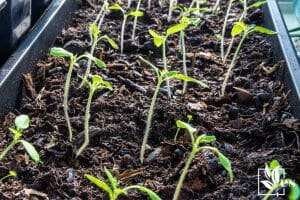 Seedling heat mat alternative options are numerous and there is no reason why you shouldn’t explore them. Let’s face it, not only are the seedling heating mats very expensive, they also come with a variety of other problems.
Seedling heat mat alternative options are numerous and there is no reason why you shouldn’t explore them. Let’s face it, not only are the seedling heating mats very expensive, they also come with a variety of other problems.
In this article, let us look at some other options readily available in the market.
JUMP TO TOPIC
What Are Alternative to Heat Mat for Seedlings?
Light boxes, heat cables, and radiators are good alternatives to heat mats for seedlings. There are several ways you can replace the electrical heat mats with other methods of germinating your seedlings at home. These methods are all well within the budget limits of your average gardener and can be easily employed.
Given below is a list of inexpensive alternatives to seedling heat mats. Read on to find out which one you like best.
– Use Light Boxes For Seedlings
This one is a great option for the handy DIY aficionados out there. It is so easy to make one’s own DIY seedling heat mat at home. Alternatively, you can simply go and get one made from a local hardware shop at very low prices.
This heating mat substitute is essentially a box in which you can house your seedling tray along with a light to heat the insides. This way, a lightbox acts as a tiny greenhouse for the seedlings.
In order to make this lightbox by yourself at home, all you need is a card box to make the walls of the container, a plastic wrap on the outside for insulation, and a light source to heat the inside of the box. An old-fashioned incandescent lightbulb will produce the light and warmth that you want in this lightbox.
Remember that the light source inside your heat box is in addition to the light source that you are already using for your seedling tray. Also, add a timer for the light inside the box. Take care that the wiring of your bulb is protected and does not come in contact with water when you irrigate your tray.
– Substitute Heat Cables for Heating Mats
These are another great alternative to the pricey heat mats. Heating cables are put under your seedling tray and hidden within a layer of sand and gravel. They tend to provide uniform heat to the soil spread above them and are a reasonable alternative to heating mats, especially when you have a large number of seedling trays to germinate and cannot afford heating mats for all of them.
Heating cables come in a variety of lengths. You can also spend some additional amount and invest in a thermostat to ensure that your seedlings are getting just the right temperature that they need for their germination.
Make sure your heating cables are of good quality and from a trusted manufacturer. Low-quality heating cables have been known to cause more harm than good in a lot of cases.
– Place the Seedling Tray on a Radiator
You can also place your seedling tray on top of your radiator and use it as a homemade seed heat mats alternative. Make sure that the temperature settings of the radiator are not set too high or your seeds will all but fry up. Also, don’t forget to use a thermometer to check the temperature of the soil frequently. You don’t want the radiator to overheat and damage your young seedlings!
Heating Mat Alternatives: Why Look for Alternatives
Sometimes you might want to look at other alternatives to these electrical heating mats. Given below are some of the reasons why.
– They Are Costly
Heat mats for seedlings are quite expensive. During the germination period, they need to be kept on 24 hours a day, which consumes a lot of electricity. They are also prone to frequent breakdowns and many people find themselves spending additional money for constant repairs and maintenance.
– The Risk of Short-circuit and Fire
Although they are waterproof, there is still a chance that water might get into the wiring and damage the seedling trays. There is always a risk of short-circuiting and the wiring catching fire involved. The risk is especially high when you try to plug in more seedling trays into the unit than it can possibly handle.
– It Can Fry Your Seedlings
Using an electric seed starter heating pad isn’t a sure-shot, guaranteed way of ensuring the successful germination of your seeds. Many times these heating pads might lead to the frying of your seedlings. This usually happens when the thermostat fails and you fail to check your soil temperatures regularly.
Substituting Heat Mats for Seeds: Some Unexpected Choices
Sometimes you have to get creative and make do with your average household appliances when you want a DIY replacement of the heated seedling mats.
Carry on reading to find out what those unexpected choices are.
– Refrigerator
No, we don’t want you to place your seedling trays inside a refrigerator. Instead, you should put them either on top of or behind the fridge. These are the areas where the heat generated by the refrigerator is released to. They make a good spot to provide the 10-20 degrees Fahrenheit rise in temperature often needed by young seedlings to germinate.
– Desktop Televisions and Computers
The old desktop type of televisions and computer monitors also generate enough heat that a seedling tray placed on top of them will definitely end up germinating. However, we doubt if any of you still own one of those in the age of LEDs and flat screens.
– Desk Lamp
A good old-fashioned desk lamp with a fluorescent bulb is another common household object you can use to place your seedling tray on. Fluorescent bulbs produce enough heat and can be a good alternative to the rather expensive seedling heat mats. Just keep in mind that the incandescent light bulb should be kept on for 24 hours a day during the entire germination period.
Seedling Heat Mats: What Are They?
Seedling heat mats are very much in demand as tools for heating trays of seedlings indoors and it seems like everyone is using them these days. Curious to find out exactly what they are and how they work? We’ve got you covered.
– Understanding Seedling Heat Mats
- Seedling heat mats are simply waterproof sheets of plastic with heating elements built into them. These heating elements are, of course, insulated to protect them from short-circuiting.
- They come in various sizes that are built to fit under the seedling tray of your choice. You can buy one that is similar in size to your seedling tray.
- Once you connect these heating pads to electricity, they will heat up and raise the temperature of the soil present in the seedling tray placed above.
- Some moderately priced seedling heating mats will only raise the temperature to a certain set point. You can also buy more expensive ones that have a built-in thermostat that allows you to set the temperature to any value that you want.
- After the growing season is over, these mats can simply be rolled over and stored for the next germination period. How convenient is that?
– How To Use Seedling Heat Mats At Home
A lot of plant seeds need average ambient temperatures of around 70 to 90 degrees Fahrenheit in order to germinate successfully. This temperature must be provided consistently, as many times seeds fail to germinate because temperatures keep falling below 50 degrees Fahrenheit throughout the day.
During certain times of the year such as late winter or early spring, temperatures aren’t consistently high enough for seeds to germinate at all. This holds most true for vegetables such as tomatoes, aubergine, etc. which would then require you to use something like a seedling heat mat to maintain adequate high temperatures.
You should form the habit of checking the temperature of your soil daily using a thermometer, even if your heating mat has a built-in thermostat in it. If the temperature seems to be higher than intended, simply raise the seedling tray a bit higher than it was before.
Remove the seedling trays from the heating mat as soon as the seeds germinate. They should now be placed under bright light and ambient temperatures. Even during colder winter months, you can put these seedling mats to use by putting heat-loving plants such as cacti and Echeveria on them.











